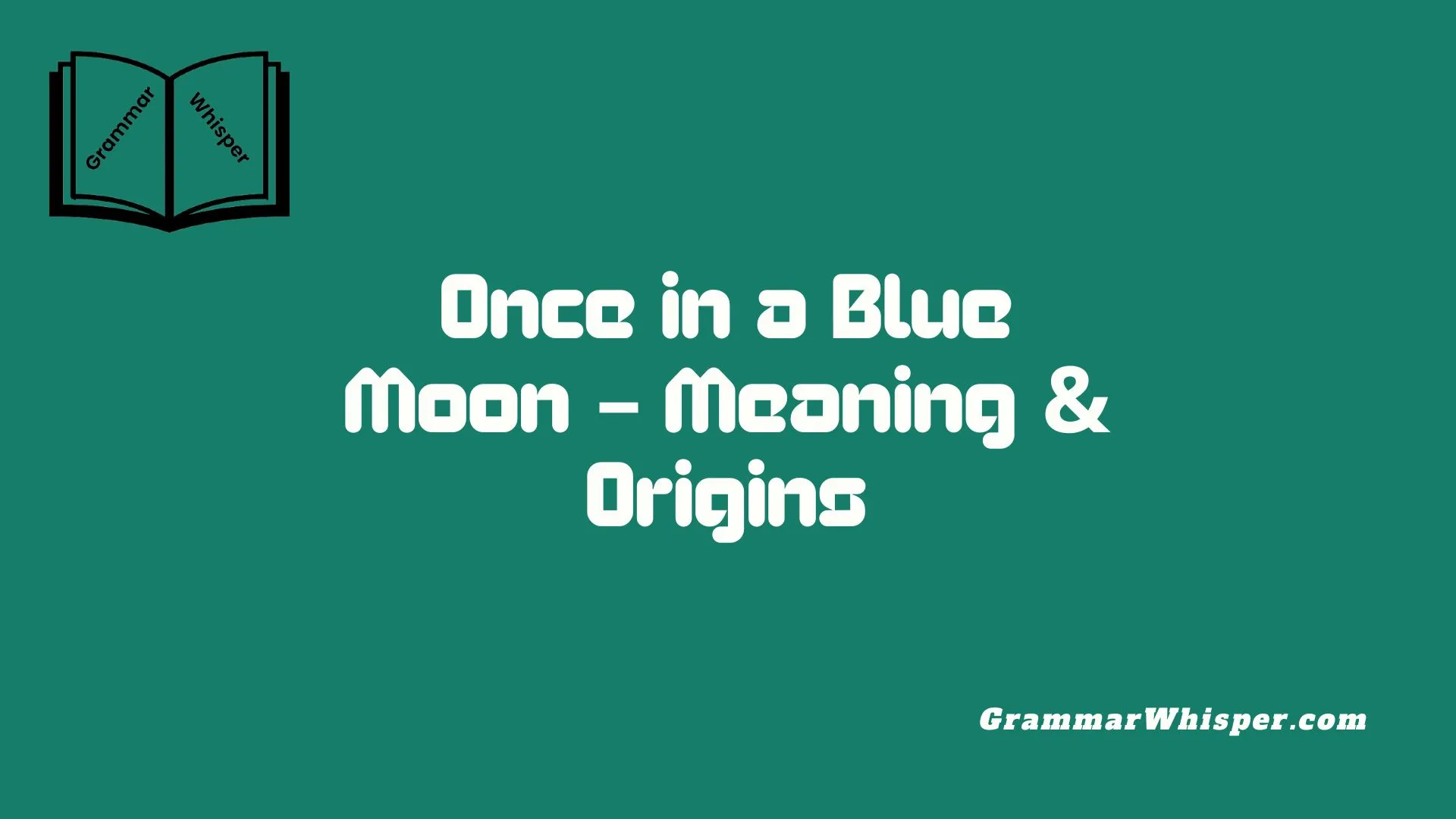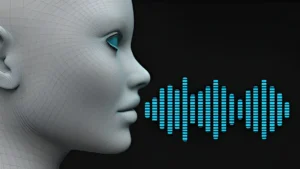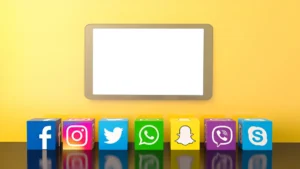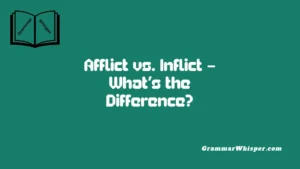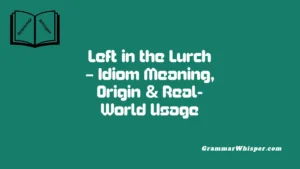The phrase “Once in a Blue Moon” is more than just an idiom – it’s a blend of language, myth, and scientific fact. I’ve always found it enchanting how a single expression can travel across cultures and capture such evocative meaning. This extraordinary term is often used in everyday conversation, but few realize it refers to the rare occurrence of a second full moon in one calendar month. This astronomical background gives the idiom its rich symbolism of rarity and uniqueness. It’s one of those gems in English that reflects both emotional depth and celestial timing.
Over time, its usage in literature, pop culture, and spoken word has shifted with the evolution of modern life. I’ve read many articles and taught lessons where this idiom was central to understanding both cultural and scientific contexts. It’s fascinating to uncover how deeply it’s woven into our collective speech, showing up in modern events or even being misunderstood by learners who take it literally. But these misuses only highlight how language grows. With in-depth exploration, we find insights into human behavior, and we learn to preserve the expressions that still feel so relevant, even after many generations.
What Does “Once in a Blue Moon” Really Mean?
In its idiomatic form, “once in a blue moon” means something that happens very rarely, almost to the point of being a once-in-a-lifetime event.
Definition:
“Once in a blue moon” refers to an event or occurrence that is extremely rare or infrequent.
People use it to express actions or situations that are out of the ordinary:
- “He only comes to the office once in a blue moon.”
- “I clean out the garage once in a blue moon.”
Synonyms and Variations:
| Phrase | Meaning |
| Once in a lifetime | Extremely rare, often unique |
| Rare as hen’s teeth | Exceptionally uncommon |
| When pigs fly | Something that will never happen |
| Once every so often | Occasional but not frequent |
Why It’s Effective
The phrase works so well because it combines natural imagery (the moon) with a sense of mystery and rarity, making it vivid and emotionally resonant.
The Real Origin of the Phrase – Not Just the Myth
Contrary to popular belief, the idiom doesn’t originate solely from the moon appearing blue. Its evolution is complex, rooted in astronomy, linguistics, and cultural misunderstandings.
Early Historical Usage
The phrase first appeared in 16th-century English literature:
“Yf they say the mone is blewe, / We must believe that it is true.” – William Roy and Jerome Barlow, 1528
Here, “blue moon” was used sarcastically to refer to something absurd or clearly false.
By the 1800s, the meaning shifted from skepticism to rarity. The Oxford English Dictionary dates the modern sense of “once in a blue moon” to the mid-19th century.
The 1946 Sky & Telescope Misinterpretation
In 1946, an article in Sky & Telescope misinterpreted a previous Farmer’s Almanac reference and incorrectly defined a blue moon as the second full moon in a single calendar month. Despite being an error, this definition gained popularity and stuck.
The Astronomical Science Behind a “Blue Moon”
In astronomy, a “blue moon” isn’t actually blue in color. It’s a rare celestial event that can be defined in two ways:
Two Accepted Definitions
| Type | Description |
| Calendar Blue Moon | Second full moon in one calendar month |
| Seasonal Blue Moon | Third full moon in a season that has four full moons |
How Rare Is It?
- A blue moon occurs approximately once every 2.5 to 3 years.
- The phenomenon is caused by the 29.5-day lunar cycle not perfectly aligning with our calendar months.
Can the Moon Actually Turn Blue?
Yes, though it’s exceedingly rare and has nothing to do with the idiom. Volcanic eruptions or large wildfires can scatter red wavelengths and make the moon appear bluish.
Example: The eruption of Krakatoa in 1883 made the moon appear blue for nearly two years due to ash particles in the atmosphere.
How the Idiom Evolved Over Centuries
The evolution of “once in a blue moon” reflects how language adapts over time through media, misunderstanding, and social reinforcement.
Key Historical Milestones
| Time Period | Milestone |
| 16th century | Used to indicate absurdity |
| 19th century | Transitioned to indicate rarity |
| 1940s | Popularized with a misdefinition in Sky & Telescope |
| Modern Era | Used figuratively to mean “very rare” |
Folk Etymology’s Role
Folk etymology helped reframe the phrase from absurdity to rarity. People found the misinterpretation more intuitive and relatable.
“Blue moon” became a stand-in for rare, unusual occurrences, like catching lightning in a bottle.
Examples from Literature, Media, and Pop Culture
Literature
- James Joyce references lunar phases as metaphors for emotions in Ulysses.
- Poets like Sylvia Plath and Ted Hughes use moon imagery to convey rarity and beauty.
Television and Film
- “Moonlighting” (TV Show): Its theme song, “Blue Moon,” romanticizes rarity.
- “Once in a Blue Moon” (1995): A family drama film highlighting rare childhood events.
Music
- Elvis Presley: “Blue Moon” (1956), a haunting ballad.
- The Mavericks: “Blue Moon” (1994), romantic country-pop.
Advertising
- Blue Moon Brewing Company uses the term to associate rarity with premium quality.
Contemporary Usage in Real Communication
Common Scenarios
- Personal: “I cook a full dinner once in a blue moon.”
- Professional: “Our CEO visits the office once in a blue moon.”
- Online: Seen in tweets, blog posts, and memes to exaggerate rarity.
Geographic Variations
| Region | Usage |
| US | Very common, informal speech |
| UK | Slightly less common, used in writing |
| Australia | Used in pop culture and casual conversation |
Humorous Twists
- “Once in a blue cheese moon” (used in food blogs)
- “Once in a Bluetooth moon” (tech puns)
Psychological and Emotional Implications of Rarity
The idiom taps into human fascination with rare events, which often feel magical or meaningful.
Why We Love Rare Things
- Scarcity triggers higher perceived value.
- Uniqueness enhances emotional impact.
- Surprise increases memorability.
“A rare moment is a sticky moment. It stays with us.” – Psychologist Dan Ariely
In Language and Storytelling
Writers use “once in a blue moon” to:
- Emphasize emotional weight
- Create contrast with the ordinary
- Signal a turning point or special occasion
Practical Examples and Sample Sentences
Here are examples showing how to use “once in a blue moon” in context.
| Context | Example Sentence |
| Personal | “I go hiking once in a blue moon.” |
| Professional | “He emails me once in a blue moon, only when there’s a problem.” |
| Academic | “That kind of result happens once in a blue moon.” |
| Sarcastic | “Oh look, he helped out. Once in a blue moon!” |
Common Mistakes to Avoid
- Misusing the phrase to describe frequent events.
- Saying “once in a blood moon” or mixing metaphors.
- Using it in formal writing where literal clarity is needed.
Idioms with Similar Meanings (and Key Differences)
| Idiom | Meaning | Nuance |
| When pigs fly | Will never happen | Pure impossibility |
| Rare as hen’s teeth | Extremely rare | Quirky and humorous |
| Once in a lifetime | Very rare, possibly only once ever | Often positive, life-changing |
Tip: Use “once in a blue moon” when something actually could happen, just very rarely.
Wrap-Up: Why This Phrase Still Matters
“Once in a blue moon” remains a vivid and emotionally resonant idiom because it combines the awe of nature with the unpredictability of human experience.
- It expresses rarity without exaggeration.
- It carries history, science, and human emotion in just five words.
- It’s flexible, used in casual speech, media, and branding.
Whether you’re writing fiction, engaging your audience online, or adding color to everyday language, this idiom offers an expressive, elegant way to highlight something truly uncommon.
Bonus: Upcoming Blue Moons Calendar
Here are the next few real astronomical blue moons (calendar-based):
| Date | Type | Notes |
| August 30, 2023 | Calendar | Second full moon in August |
| May 31, 2026 | Seasonal | Third of four full moons in spring |
| December 31, 2028 | Calendar | Rare New Year’s Eve blue moon |
| August 21, 2032 | Seasonal | Four full moons in a summer season |
Final Thoughts
“Once in a blue moon” is more than just a pretty phrase – it’s a powerful way to express rarity in a relatable, poetic, and memorable way.
Its staying power lies in how it blends natural wonder, linguistic evolution, and cultural charm into a single idiom. From its sarcastic beginnings in the 16th century to its place in modern memes and marketing, it has continuously adapted while retaining its core meaning.
So, whether you’re reflecting on rare moments in life, making your writing more colorful, or just having a bit of fun with language – this idiom will serve you well.
FAQs
How often does a blue moon occur?
A blue moon occurs approximately every 2.5 to 3 years, based on lunar cycles that don’t perfectly align with calendar months or seasons.
Can the moon actually appear blue?
Yes, but it’s unrelated to the idiom. The moon can look blue due to atmospheric conditions like volcanic ash or wildfire smoke, which scatter red light.
Is “once in a blue moon” formal or informal?
It is considered informal and is best suited for casual conversations, creative writing, or light-hearted professional contexts – not formal academic work.
What’s the difference between a calendar blue moon and a seasonal blue moon?
A calendar blue moon is the second full moon in a calendar month, while a seasonal blue moon is the third full moon in a season with four full moons.
Are there idioms similar to “once in a blue moon”?
Yes. Similar idioms include “when pigs fly” (never), “rare as hen’s teeth” (very rare), and “once in a lifetime” (exceptionally rare but possible).
